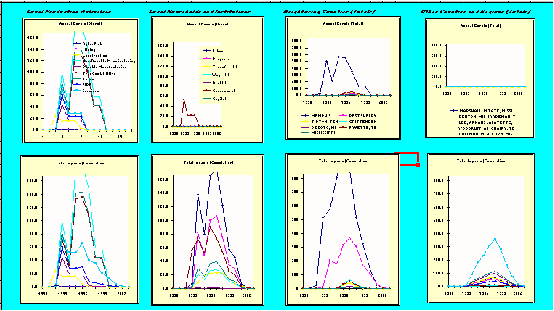This paper describes a decision support system (DSS) to provide guidance for disaster relief efforts in small sub-county localities in the United States - such as rural districts and inner city neighborhoods that are typically hardest hit by disasters, or clusters of counties situated near the epicenter of an earthquake or in a river flood plain, or coastal communities endangered by tsunami or hurricanes. Within these locales, disasters often impact most severely on poor and marginal populations. In many cases, this can be traced to poverty, inferior infrastructure or housing, or limited insurance and other defensive resources. For similar reasons, disasters tend to impact small businesses more severely than large enterprises. Ideally, a model should describe the situation of these groups and activities explicitly, as well as their links with the wider economy and community. Since natural disasters typically take place with rather little specific warning, planning tools should be adaptable to the situation of any community and type of damage, and should become available as soon as possible after the disaster, so that they can be used to evaluate alternative proposals for recovery, before irreversible commitments are made. Even after a disaster has occurred, there remains considerable uncertainty as to the extent of damage or the most appropriate recovery strategy, the model should be updatable and flexible, so as to respond to evolving community needs.
Paradoxically, to develop the requisite analytic procedures for to provide suitable county and sub-county models, it was necessary to construct first a detailed county-level many-region set of social accounts for the entire United States. This provides the parameters necessary to estimate models for smaller localities, and transactions between counties across the entire United States, providing indirect estimates of information that are otherwise not readily available. To deal with this vast amount of data, the system is organized as a "virtual model" whereby the many-region accounts focus in on the segment of the matrix that describes the disaster area, in much the same way that a GIS system allows us to zoom a particular geography.
The social accounts provide a county-by-county pre-disaster picture of the network of domestic transactions and flows to and from neighboring regions. During a disaster, some of the nodes and links in this many-region economic network are damaged, while others may take up the slack during the recovery. The method used to solve the model attempts to capture this process in a generalizable way. This approach recognizes that, even under normal circumstances, some proportion of transactions will be delayed unacceptably. For this reason, firms attempt to reduce losses by maintaining buffer stocks, or concentrating their business in nearby markets. During a "disaster" - almost by definition - the proportion of failed transactions is increased beyond the capability of the normal system to cushion their livelihood. Thus, their economic losses increase dramatically. The distribution of losses across localities and time are calculated and displayed in maps and graphs. In the Figure, the upper charts show respectively the direct impacts on the impacted locale, its near neighbors, and the rest of the region, while the lower charts show the total (direct plus indirect impacts).

Various strategies to reduce or redistribute the impacts may be explored
using the model. These calculations illustrate a number of important points. Not least is
that, while significant overall savings are possible, economic actors are likely to be
impacted unevenly. Even a fairly innocuous goal such as reducing losses to community-wide
value added is not in the interests of all individual industries or communities. From a
policy perspective, the last conclusion emphasizes that strategies chosen to deal with any
untoward and disastrous incident is inevitably a matter of negotiation between the
affected parties. In the example used in the paper, an overarching question is, if the
community loses a given amount of electricity supply how might the cutbacks be distributed
in order to minimize the ensuing impacts to selected interests in a mutually acceptable
manner? The aim is to provide analysis that can deal with the tradeoffs between economic
and non-economic welfare, and the competing needs of various interest groups and
communities.